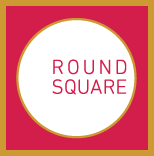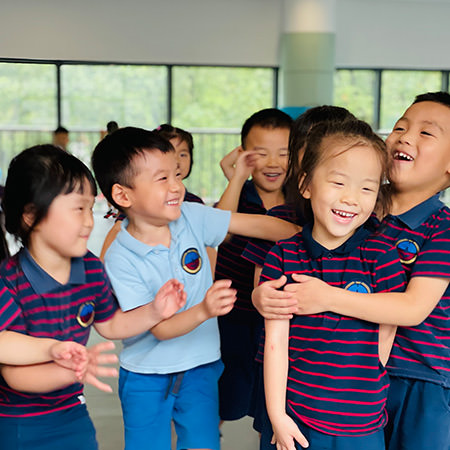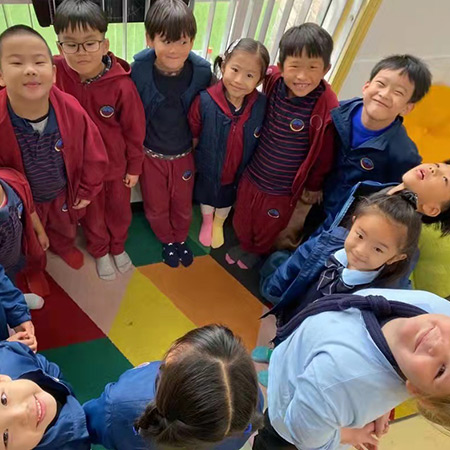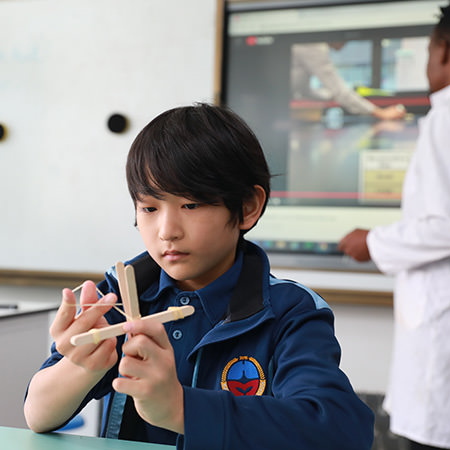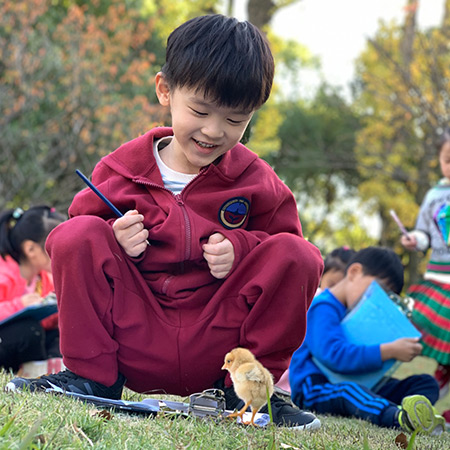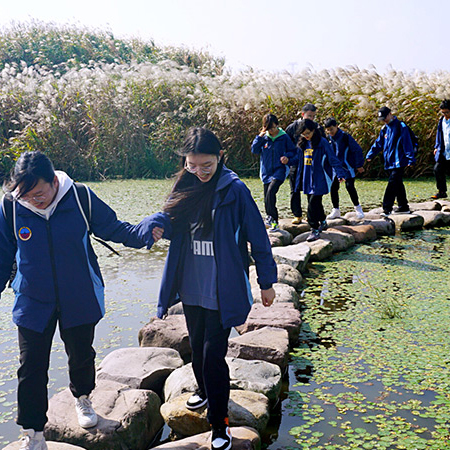OUR PROGRAMMES
Libraries at NBHIS
Kindergarten Library
In the kindergarten library, we provide children with a quiet and warm reading environment, allowing children to gain emotional enjoyment through listening, reading, and seeing, broaden their horizons, enrich their life experience, and enhance their imagination and language skills. In order to meet the different needs of children, the library is divided into four areas: dynamic area (hand puppet show, free reading, good book sharing), static area (reading area, new book recommendation), book repair area and DIY book area. It provides comfortable cushions, beanbags, tents for children, and is also equipped with story tapes, hand puppets, plush toys, paper and pens and other auxiliary materials.

Primary School Library: NBHIS PYP library offers the students with reading and periodical resources that can help students with their education. Students use the library to research or simply find a quiet space to read or complete their school work. The library provides and promote social and recreational resources to teachers and students, thus promoting the enjoyment of reading, viewing, and listening in our school community.
Library involves enforcement of ATL skills which has been a big emphasis in our school in recent times. Students learn to work better within their groups (social-collaboration skills), research and thinking skills, time and self-management skills, and be able to share those skills amongst themselves in the true spirit of caring as espoused in the IB learner profile. Our students also use library websites effectively and efficiently.
Y1 to Y3
Students use think-pair-share methods to deepen discussions about specific characters they read about in books either in the class or leisurely at home. Students are encouraged to treat each other with dignity and respect, being kind to each other acknowledging that we are all friends in the classrooms. Students also use picture books to learn about IB learners profile traits.
Y4 to Y6
Students learn how to research during the library class and library project. They use the library resources to connect the resources we have with the project/UOI. Students learn that the library is a place where they can engage in various academic activities other than just borrowing, checking or reading books. They are encouraged to think before they choose a book and share what they have read about with their peers.

Middle and High School Library
Middle and High School Library supports the process of teaching and learning for MYP, DP and NAP. Curriculum needs and access to resources remain the focal purpose of the space. Library helps teachers in planning and development of courses including research tasks. It maintains a constructive learning and teaching environment at all times. There is a collection of more than five thousand physical books in the library, including fictions, non-fictions, magazines and reference books, as well as areas for HI-LO books, collection of IB TOK readings, IBDP subject study cards, and college admissions guiders.
This library is
- A place to read: Middle school students come to the library with teachers to read and learn. High school students come to the library by themselves. They can borrow three
books at one time for two weeks and renew the books if they still want to read them. - A place to research: There are non-fiction books and reference books in the library to help students with research, and students can also use the online resources.
- A place to study: High School students come to study by themselves in the library. They can enjoy a quiet place to do school work, do researches and write papers.

Online Resources:
- Reading A-Z (PYP Only)
- Literacy Planet (PYP Only)
NBHIS Art ProgrammE
Primary School
The PYP art course provides students with a platform for artistic creation experience, through which they can continuously diverge their creative thinking, express their thoughts and within the following elements:
– Line – Shape – Color – Value – Form – Texture

PYP’s art courses are divided into four sections: painting performance, design application, appreciation and comment, and comprehensive exploration. Among them, students will be exposed to different visual fields through game exploration and various cooperative activities, including painting, graphic design, and printmaking, sculpture, architecture, ceramics, collage, costume design, comics, land art, mask making, etc. Cultivate students to appreciate and experience the visual arts of different cultures, creatively explore personal interests and develop their own artistic creation styles.
Y1
Students experience the fun of art creation with different materials through game, painting, and hand making, learn basic art shape and color elements to stimulate students’ interest in creation.
Y2
Students try more art tools and production methods, understand different art forms in different cultural and geographical backgrounds, and improve students’ artistic observation and drawing creation ability.
Y3
Students are exposed to themed creative painting, model making and manual design combined with their UOI, cross-disciplinary learning, combining Science, Chinese, English and other disciplines to derive, through various explorations and experiments to study the expression of art language, and then apply it to art in creation.
Y4
Students pay more attention to the field of design, feel the texture and material of different materials, explore methods and ways to change materials, use them in design and creation, and apply them in life, and continuously improve students’ design and thinking skills.
Y5
Students explore and study more independently, reflecting and discussing Chinese and foreign art works through the searching and collection sorting of related art materials, group cooperation and exploratory reports. Through sketching, multimedia production, writing research reports and other forms to improve art painting techniques and appreciation ability. Students will more consciously choose their favorite art methods to express their art creation and ideas.
Y6
In sixth grade art, students explore a variety of media as they continue to build their skills in drawing, painting, graphics, calligraphy, and sculpture. Theory is introduced to further elaborate upon ideas about color, perspective, and design. We discuss artists, artwork, and provide technique demonstrations to develop the four strands of art education: art appreciation, art history, art production, and art criticism; as well as problem-solving and critical thinking skills. Students focus on vocabulary, creativity, and purpose of different mediums and materials. Two-dimensional lessons include painting, college, drawing, and printmaking. Three-dimensional projects include functiona l or sculptural ceramic experiences. Art history,art appreciation, and art criticism are integrated into the lessons as a framework of the curriculum.

VISUAL ARTS in the Diploma:
The visual arts are an integral part of everyday life, permeating all levels of human creativity, expression, communication and understanding. The IB Diploma Programme visual arts course encourages students to challenge their own creative and cultural expectations and boundaries. It is a thought-provoking course in which students develop analytical skills in problem-solving and divergent thinking, while working towards technical proficiency and confidence as art-makers. The course is designed for students who want to go on to study visual arts in higher education as well as for those who are seeking lifelong enrichment through visual arts.
ASSESSMENT FOR VISUAL ARTS
- Exhibition (40%)
- Comparative Study (20%)
- Process Portfolio (40%)
FREQUENTLY ASKED QUESTIONS
It is a Critical research and analysis of other artist’s work in term of historical context and impact on audience.
It’s the evidence of the student’s unique art-making process along the 2 years of Diploma.
The Annual Art Exhibition happens on year 12 and it displays the work of our students for assessment. It is a celebration of their creative journey and we invite the whole school community and their parents to join us.
You do not have to be a skillful artist but some basic knowledge of artistic techniques is necessary.
Of course, you can. The Visual Arts subject is for anyone who enjoys making art and wants to learn more about it.
No, there are not exams but you have to upload three tasks (components) for final assessment.
Ningbo Huamao International School Music Programme
Primary School
The PYP Music Course offers students a medium through which they can learn about themselves and in which they can articulate and express their thoughts, ideas and feelings. We focus on the following segmented elements:
– Tempo, Beat, Metre, Rhythm, Melody, Harmony, Dynamics, Articulation, form, phrasing
Students will have the opportunities to identify and reflect upon “big ideas” by making connections between the musical elements. They will use notation to develop musical ideas. They will also develop an awareness and appreciation of music from different cultures and be able to describe and compare sounds using appropriate musical vocabulary.
Y1
Students gain an awareness and appreciation of music in all its forms from a range of times, places and cultures. Students have opportunities to experiment with sounds to make expressive use of musical elements and simple appropriate musical vocabulary.
Y2
Students apply the use of musical elements through the singing of songs and the playing of instruments. Students have opportunities to identify and reflect upon musical ideas by playing rhythmic patterns with various class percussion instruments.
Y3
Students develop the ability to perform confidently through singing songs, joining folk dances and playing instruments. They listen with greater understanding of a range of music from different times and places. Students also develop control of sounds on the recorder.
Y4
Students develop musical ideas in simple composition using non-traditional and traditional notation. They play musical pieces using a range of instruments to demonstrate style, expression, and an understanding of melodic direction, tempo and dynamics.
Y5
Students expand their appreciation of diversity by listening to music from different cultures whilst making connections with the common musical elements. They start to compose using notation software as a way to build on previous knowledge and theory. Students learn to refine their work based on feedback and audience response.
Y6
Students are introduced to self-directed ensemble work, which involves planning, rehearsing and executing songs of contrasting styles. For composition they explore software like Musescore for traditional notation and Garageband for sequencing contemporary style music. A careful balance between acquiring Music Technology and acoustic instrument skills is followed in order to best prepare them for MYP and beyond.

Middle School
The NBHIS Middle School and High School Music Programs offer pathways of study for developing skills and building on content knowledge gained from the K-6 music experiences. The program offers rich opportunities for self-expression and musical growth. Playing music is enjoyable, and exciting for students, as they learn to read music, use proper hand positions and embouchures (mouth positions), be part of an ensemble or group, and express themselves through music.
Students engage in a comprehensive curriculum that promotes hands-on learning. Experiences range from literacy with the elements of music to beginning composition and opportunities with music technology. Teachers support students to make connections between historical, social, and cultural events and music. Students are encouraged to develop an appreciation of all types of music through listening, analyzing, evaluating, and composing skills. The have opportunities to showcase their knowledge and skills learned through original, creative projects.
Diploma Programme
The DP Music course encourages students to explore music as creators, performers, and researchers. Students develop their skills through creating, performing, and critical listening, while exploring a range of musical styles and contexts. This well-rounded approach fosters creativity, self-expression, and a deeper understanding of music’s role in society, preparing students for future opportunities in the arts and beyond.
| Higher level Exploring Music in Context (20%) Experimenting with Music (20%) Presenting and Creating (30%) Contemporary Music Maker (30%) |
Standard level Exploring Music in Context (30%) Experimenting with Music (30%) Presenting and Creating (40%) |

 中文
中文
